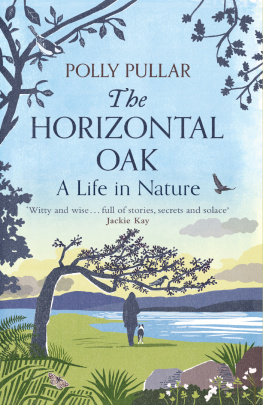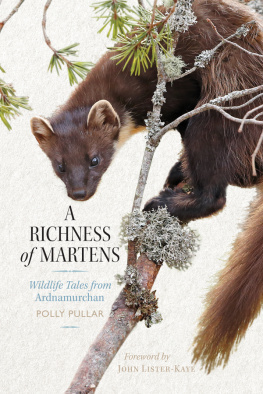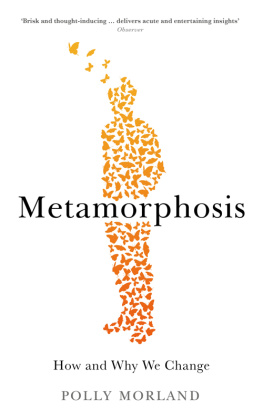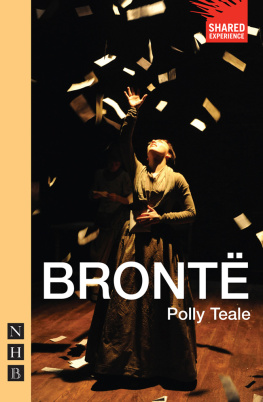Polly Pullar - The Horizontal Oak: A Life in Nature
Here you can read online Polly Pullar - The Horizontal Oak: A Life in Nature full text of the book (entire story) in english for free. Download pdf and epub, get meaning, cover and reviews about this ebook. year: 2022, publisher: Birlinn, genre: Non-fiction. Description of the work, (preface) as well as reviews are available. Best literature library LitArk.com created for fans of good reading and offers a wide selection of genres:
Romance novel
Science fiction
Adventure
Detective
Science
History
Home and family
Prose
Art
Politics
Computer
Non-fiction
Religion
Business
Children
Humor
Choose a favorite category and find really read worthwhile books. Enjoy immersion in the world of imagination, feel the emotions of the characters or learn something new for yourself, make an fascinating discovery.
- Book:The Horizontal Oak: A Life in Nature
- Author:
- Publisher:Birlinn
- Genre:
- Year:2022
- Rating:3 / 5
- Favourites:Add to favourites
- Your mark:
- 60
- 1
- 2
- 3
- 4
- 5
The Horizontal Oak: A Life in Nature: summary, description and annotation
We offer to read an annotation, description, summary or preface (depends on what the author of the book "The Horizontal Oak: A Life in Nature" wrote himself). If you haven't found the necessary information about the book — write in the comments, we will try to find it.
The Horizontal Oak: A Life in Nature — read online for free the complete book (whole text) full work
Below is the text of the book, divided by pages. System saving the place of the last page read, allows you to conveniently read the book "The Horizontal Oak: A Life in Nature" online for free, without having to search again every time where you left off. Put a bookmark, and you can go to the page where you finished reading at any time.
Font size:
Interval:
Bookmark:

Polly Pullar is a field naturalist, wildlife rehabilitator and photographer. She is also an acclaimed wildlife writer and contributes to a wide range of publications, including BBC Wildlife, the Scots Magazine, Scottish Field and Scottish Wildlife. Her previous books include A Richness of Martens Wildlife Tales from the Highlands and A Scurry of Squirrels Nurturing the Wild. She lives on a small farm in Highland Perthshire surrounded by an extensive menagerie. Follow her on Twitter: @pollypullar1.
The Horizontal Oak
A Life in Nature
Polly Pullar

First published in 2022 by
Birlinn Ltd
West Newington House
10 Newington Road
Edinburgh EH9 1QS
www.birlinn.co.uk
Copyright Polly Pullar 2022
ISBN 978 1 78027 780 6
This book is a work of non-fiction, however some names and identifying details have been changed to protect the privacy of the people involved.
All rights reserved. No part of this publication may be reproduced, stored, or transmitted in any form, or by any means, electronic, mechanical or photocopying, recording or otherwise, without the express written permission of the publisher.
The right of Polly Pullar to be identified as Author of this work has been asserted by her in accordance with the Copyright, Designs and Patents Act 1988.
All rights reserved. No part of this publication may be reproduced in any form or by any means without permission from the publisher.
British Library Cataloguing in Publication Data
A catalogue record for this book is available from the British Library.
Typeset by Initial Typesetting Services, Edinburgh

Printed and bound by Clays Ltd, Elcograf S.p.A.
For Freddy
With all my love
Theres a single oak high on the flank of Ben Hiant, overlooking the Sound of Mull. I have known this resilient tree since my early childhood. Its in a place I love very much. Massaged by the warmth of the Gulf Stream, battered by the wrath of the Atlantic and silhouetted by a thousand sunsets over the islands of Mull, Coll and Tiree, it is horizontal, its trunk fissured and colonised by tiny ferns. An oak sustains more life forms than any other native tree. Generally, we think of oaks as mighty: trees for building houses, boats or bastions; trees of grandiose parklands, their massive weighty boughs stretching to the heavens. The oaks of Scotlands rainforest on the western seaboard are different: diminutive, wind-sculpted. Many do not stay the course while others, like mine, grow strong and beautiful as they find succour between a rock and a hard place. Raven, hooded crow, buzzard and tawny owl frequently visit this tree. Sometimes it will be the little stonechat with his dapper black bonnet. And, from time to time, it is me, for its trunk, having withstood so much abuse, offers me support too; the horizontal oak, high on a hillside west of the sun.
*
Ordinary families like mine hide secrets, issues and struggles that cause pain. When my mother died, I knew that it was time to come to terms with the strains of my relationship with my parents. For far too many years this consumed me, spiralling out of control and leading to tragedy. I usually write about nature and have found writing about personal issues troubling, yet this journey has been burning deep in my heart for a long time.
In nature in wild places, and through some extraordinary close relationships with animals and birds, both wild and domestic I have found the peace that nurtures my soul. In particular, I have returned again and again to Ardnamurchan, a remote, mercurial peninsula flung west towards the setting sun, where nature embraces me in its many moods. And to that oak tree; its as fine a place as I know for reflection. And calm.
Few are lucky enough to avoid lifes emotional battles, but it is how we survive them that matters. Do we cling on and become more weathered and lined, like my horizontal oak, or do we instead blow over with the first hard gust of wind? Perhaps this nagging at our roots strengthens us, and maybe even leads us to a better understanding of the problems we all face.
My life and work are woven around nature. The natural world forms a vital part of this memoir and provides a continual counter-balance of hope. Hope and a sense of humour are essential emotional ingredients for life. Laughter helps us find ways to continue when things are testing. Here, then, is a little part of that story.
Polly, you are so lucky to have owls in your ovaries. I was peering through the kitchen window watching tawny owlets in the aviary in the garden with a friends eight-year-old daughter. Children do not realise the power and wisdom of their priceless statements. It was appropriate because wildlife has always been part of my very being, though perhaps not my ovaries. She was right; I consider myself fortunate to work closely with injured and orphaned wild animals and birds. As well as making me laugh, her statement brought forward a vivid memory from the annals of my mind, from Cheshire, around 1966: that morning when I discovered my first tawny owl.
The garden was an amphitheatre of birdsong. It drifted through my open bedroom window. Jackdaws were ferrying twigs to the collapsing chimney in the old stables next to the house. One of them had long wisps of sheeps wool in its bill it looked like a Chinese wise man with a drooping white moustache. I listened to their effusive chatter, so many different calls, some almost human. The fireplace in the wood-panelled tack room bulged with sticks and twigs spewing forth onto the cracked stone floor. Sometimes I collected them for Mum to use as kindling. They were surplus to the jackdaws requirements for they only used the ones at the top to create their shambling nurseries. In a continuous stream, more and more sticks were flown in, and the chimney echoed to the sound of their chortling, chakking communications with their voracious youngsters.
A dead jackdaw lay rotting in a verdant grave of emerging nettles close by. It had died a week earlier, but I didnt know why. Id found it when it was still warm, its smoky hood and glossed indigo-black plumage fresh, its eyes topaz blue. There was not even a speck of blood to reveal a fight with one of its kind; perhaps it had had a disease. Id wished I could have saved it. I raced outside for another quick look before school. That day the birds eyes were sunken, the blue faded to storm-cloud grey, and its feet clenched in a death grip, claws earthy under sharp nails. I turned it over with my foot, watching iridescent beetles and creamy maggots working on its decaying flesh. The smell was overpowering, but the bird was moving in an intriguing way. Beside the gruesome scene, there was a splash of brilliance: celandines and dandelions were opening their bright faces. The bird had flowers on its grave.
I heard a soft churring sound, almost inaudible, merely a whisper. It was close. I had never heard it before. I looked up and saw an owl perched in the open hayloft doorway above me, its burnished bronze plumage dappled with light rays that briefly illuminated festoons of lacy cobwebs around the corners of the opening. It was the most beautiful bird I had ever seen. It drew itself up tall as if to make itself invisible, narrowing its huge dark eyes to mere slits, and then it swayed its body over to lean up against the sandstone. I stood motionless, captivated.
Font size:
Interval:
Bookmark:
Similar books «The Horizontal Oak: A Life in Nature»
Look at similar books to The Horizontal Oak: A Life in Nature. We have selected literature similar in name and meaning in the hope of providing readers with more options to find new, interesting, not yet read works.
Discussion, reviews of the book The Horizontal Oak: A Life in Nature and just readers' own opinions. Leave your comments, write what you think about the work, its meaning or the main characters. Specify what exactly you liked and what you didn't like, and why you think so.










